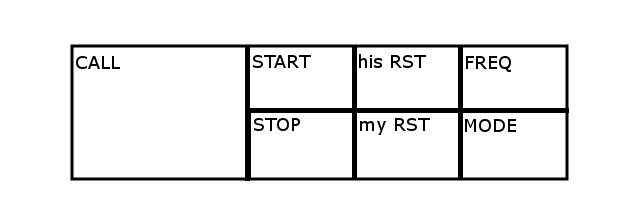
OG! official logo, copyright © 2015 Dave Casler
Colors (RGB): Blue filler, 219, 219, 255. Red letters: 204, 0, 0. Black: 0, 0, 0.

OG! official logo, copyright © 2015 Dave Casler
Colors (RGB): Blue filler, 219, 219, 255. Red letters: 204, 0, 0. Black: 0, 0, 0.
Here’s an update from Don Degidio with space for the date added:

Updated from Don with sharpened lettering
In Ask Dave 18, I showed a rubber stamp that I use to create an entry in an ordinary notebook for logging. Gwen Patton, N3GP, has recreated the image of the log stamp for anyone who’d like to recreate the stamp for their own use. Here is the image:

Clear image of my logging stamp for use with any notebook. Thanks Gwen Patton, NG3P.

Here’s the rubber stamp I had made at a local stationery store, sitting on an American 3″ x 5″ card for size comparison.
Here are the charts I used in Ask Dave 14, “Anatomy of a CW QSO,” by request. These PDF charts walk you through a typical exchange for a brief conversation in Morse Code.
Click on this: A typical CW exchange.
I hope the charts help you be more comfortable on CW!
Watch the time lapse photography as I assemble the MFJ-1846 six-band hex-beam antenna. I also explain how hex beams work.
You can see a list of Ask Dave videos by clicking here. You can ask a question by clicking here. You can go to my YouTube channel by clicking here. And the tip jar is available by clicking here.
Ray Nelson is one of the principles at MPD Digital (usacoax.com). I spoke with him at length about connectors for coaxial cable. Enjoy our 30-minute chat!
You can see a list of Ask Dave videos by clicking here. You can ask a question by clicking here. You can go to my YouTube channel by clicking here. And the tip jar is available by clicking here.
What can we learn about the Inverted Vee HF single-band antenna from the EZNEC+ model? Lots of things, having to do with height above ground, the amount of spreading, and using a metal pole as a mast. Tune in for full details!
You can see a list of Ask Dave videos by clicking here. You can ask a question by clicking here. You can go to my YouTube channel by clicking here. And the tip jar is available by clicking here.
Viewers queried me about what happens when you shorten a dipole by letting the ends hang down, or have to put up a dipole that can’t be in a straight line, and I was also curious about the effect of my aluminum masts on horizontal dipole performance. EZNEC+ to the rescue. The video shows that modified dipoles can work quite well.
You can see a list of Ask Dave videos by clicking here. You can ask a question by clicking here. You can go to my YouTube channel by clicking here. And the tip jar is available by clicking here.
These strange atmospheric formations are weird! I’ve never seen anything like them. Okay all you weather scientists out there, what are they?
You can see a list of Ask Dave videos by clicking here. You can ask a question by clicking here. You can go to my YouTube channel by clicking here. And the tip jar is available by clicking here.
How high should a dipole be? What happens if it’s too low or too high? We turn to EZNEC antenna modeling software to see that the old rule of thumb of one half wavelength is correct. But there are lots of things going on! Learn about modeling and dipoles in this video.
You can see a list of Ask Dave videos by clicking here. You can ask a question by clicking here. You can go to my YouTube channel by clicking here. And the tip jar is available by clicking here.